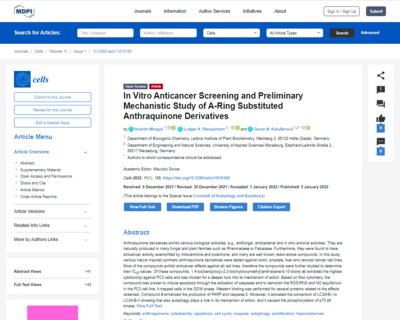Synthetic anthraquinone derivatives show good anticancer activity.
Anthraquinone and its derivatives are bioactive compounds with multiple antibiotic and anticancer activities. The aromatic compounds occur in various plant families, such as Fabaceae and Hypericaceae, but are also found in fungi and insects. IPB scientists recently tested 29 synthetic anthraquinone derivatives for their activity against various cancer cell lines. As a reference, they used anthraquinone and emodin - a natural anthraquinone derivative from the rhubarb species Rheum palmatum, which is already used in the treatment of various types of cancer.
Most of the compounds studied showed inhibitory activity against all cell lines tested, i.e., colon, prostate, liver, and cervical cancer cells. The highest cytotoxic activity against prostate carcinoma cells was shown by the compound 1,4-bis(benzyloxy)-2,3-bis(hydroxymethyl)anthracene-9,10-dione. This compound, according to the results of further studies, activates the caspase pathway in the malignant cells, triggering programmed cell death. With an IC50 of 4.65 µM, this synthetic anthraquinone derivative was about six times more potent than the natural reference emodin. All anthraquinone compounds studied were obtained from the institute's compound library and are very similar to natural anthraquinones.
Natural anthraquinones from various plants are already used occasionally as laxatives, antimalarials and anticancer agents. Their synthetic derivatives have applications in the dye and paper industries and in the production of hydrogen peroxide. Based on the fact that nature frequently harnesses these compounds to achieve certain effects, the authors advocate for elucidating their medicinal potential and the corresponding mechanisms of action.


